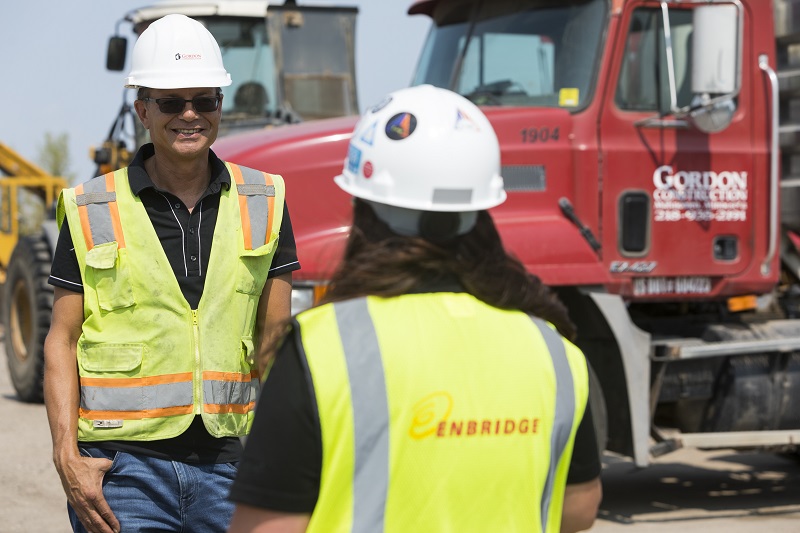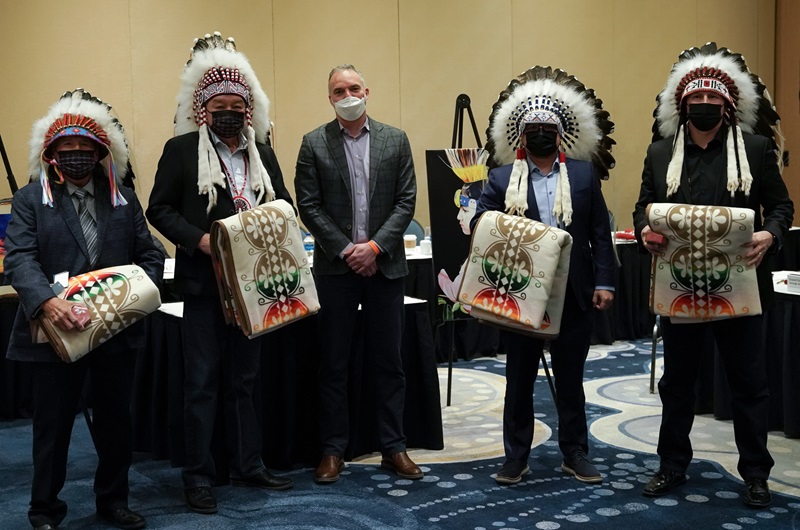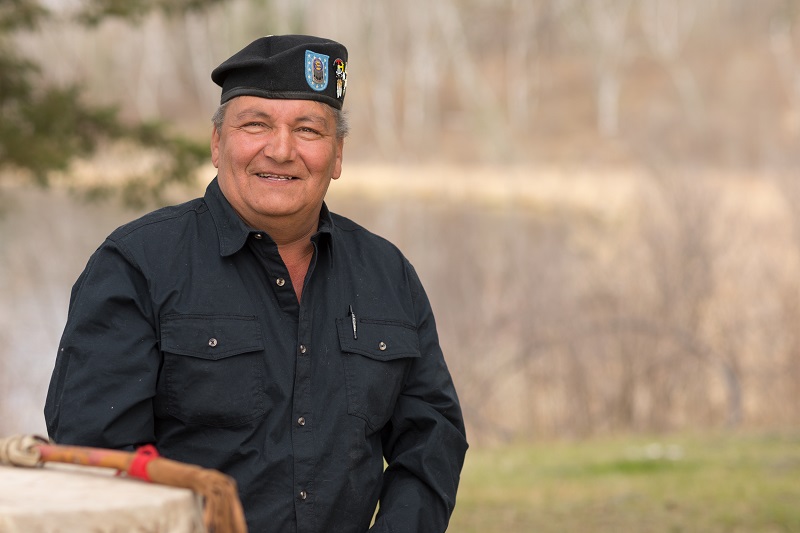Setting up for success
In order to live our values and effectively and consistently implement our IPP commitments, we have worked internally across our organization to improve how we execute our objectives and commitments around Indigenous engagement and inclusion.
This has been an important step to establish clarity on responsibilities and accountabilities and to help guide engagement that must be both consistent and flexible—taking into account the uniqueness of the geographic regions we work within and Indigenous groups with whom we engage. We continue to listen, learn and adapt—always with the objectives of improving how we build stronger relationships and working partnerships.
We are grateful for the time and energy many Indigenous leaders, Elders and Indigenous groups have provided to us while engaging on project plans, our operations and activities. By sharing their perspectives, interests and traditional and cultural knowledge, and outlining the needs and skills of their respective Nations, groups and Governments we strengthen our relationships and improve the outcomes.
Lifecycle approach
We are committed to building respectful, constructive, and enduring relationships that foster trust with and generate benefits for Indigenous groups over the lifecycle of our assets – from project proposals and design through construction, operations, maintenance and, to ultimately and safely removing a pipeline from service at the end of its useful life1. We recognize consistency and continuity are important to developing and maintaining positive relationships. Long-term relationships are built on trust and respect, and are critical to creating sustainable and mutually beneficial outcomes.
We have come to recognize the need for continual engagement—not just when we’re actively working in an area or during a project, but constantly and consistently with all those in proximity to our operating assets.
In 2019, we adopted our Indigenous Lifecycle Engagement Framework, which operationalizes our commitment and outlines internal guidelines for engagement with Indigenous groups. The framework ensures consistent engagement approaches and standards of practice across our operating regions in North America. It embeds our commitment to creating systemic and sustainable opportunities for Indigenous inclusion into our foundational processes going forward.
Through our dynamic engagement process, we are listening and learning about the interests, needs and values of the people and communities who live and work near our projects and operations. This information continues to help inform and shape our lifecycle approach. As the world changes, we expect the needs of communities to evolve, our knowledge to increase, and our framework to continue to change and grow in response.
Through the implementation of the framework in 2019, we have introduced a number of standards of practice to provide a consistent, respectful approach that aims to recognize the diversity and uniqueness of the Indigenous groups with whom we engage. This includes:
- Long-term agreements and engagement protocols during our operations that outline expectations and provide an avenue for ongoing information sharing and relationship building.
- Financial participation and inclusion, including direct Indigenous participation on new or greenfield projects.
- Increased transparency and participation in historical site remediation, maintenance digs, use of Indigenous Traditional Knowledge/Traditional Land Use data; and facilitation of Indigenous participation, especially as it relates to protecting Indigenous cultural resources and sites.
- Creating awareness of and encouraging participation in Enbridge’s emergency response.
- The engagement and inclusion of Indigenous contractors and businesses through the use of tools such as our Socio-Economic Requirements of Contractors.
Oversight of the framework’s implementation and our approach to Indigenous engagement continues to be through an Executive Steering Committee comprised of a cross-section of members of our senior executive leadership team, thereby reinforcing the integration of the framework across the company. Ongoing responsibility for living our values and commitments around Indigenous inclusion permeates the organization through multidisciplinary teams and our Indigenous Employee Resource Group (ERG). This internal group, comprised of Indigenous employees and allies from across the company, provides Indigenous perspective and advice, supports Indigenous employees and creates awareness and understanding of Indigenous history and culture.
1 Removing the pipeline from service is called decommissioning in Canada and deactivation in the United States.

Gordon Construction, an Indigenous company involved in Line 3 Replacement Project construction in the U.S.
Spotlight: Innovation in engagement
With the onset of the COVID-19 pandemic, stay-at-home orders issued across North America and with Indigenous communities locked down to outside visitors, Enbridge, like so many organizations and individuals globally, needed to find new and innovative ways to remain connected. We transitioned from in-person to virtual/online workshops and meetings to deliver materials, provide opportunities for dialogue, seek feedback on our projects, and continue to ensure inclusion in field activities.
In Eastern Canada, this included taking archaeological field survey video footage to share with Indigenous groups to facilitate virtual monitoring of proposed projects. In the Prairie provinces, we shifted from in-person roundtable sessions with Indigenous groups to hosting webcasts to provide updates on the Line 3 Replacement Program, including the Line 3 Decommissioning regulatory filings. In northeast British Columbia, this meant mounting video cameras on helicopters completing area flyovers to share and review with Indigenous communities to facilitate discussions around caribou habitat restoration.
Plans in action: A pioneering economic and environmental partnership (Alberta)
In February 2022, Enbridge and five Indigenous communities in Alberta announced our intention to partner to advance a proposed carbon transportation and storage hub west of Edmonton.
Once built, the Open Access Wabamun Carbon Hub will transport captured carbon-dioxide (CO2) via pipeline, from large industrial operators (such as Capital Power and Lehigh Cement) in the west-Edmonton region, and safely and permanently sequester it in deep underground geological formations. Such projects are seen by organizations like the International Energy Agency as critical if countries like Canada are going to effectively combat climate change and achieve near- and long-term goals, including net-zero emissions by 2050.
The Hub proposal is being evaluated by the Alberta government, which is expected to award the rights to sequester the CO2 underground in various regions of the province in a phased approached beginning in the first half of 2022.
Four Treaty 6 Nations which make up the First Nations Capital Investment Partnership (Alexander First Nation, Alexis First Nation, Enoch Cree Nation and Paul First Nation), have signed an agreement with Enbridge to pursue ownership in future carbon transportation and storage projects associated with the Hub. Under a separate agreement, the Lac Ste. Anne Métis Community will also have an opportunity to acquire an equity interest.
As carbon transportation and storage projects proceed within the Hub, Enbridge will look to utilize Indigenous contractors as direct contractors, subcontractors and suppliers..
“This path creates an opportunity to generate wealth, but more importantly it allows sustainable economic sovereignty for our communities. We are creating a healthy future for the next seven generations to thrive. We’re looking forward to working with industry leaders who share our values of environmental stewardship and to collaborate with Enbridge on world-scale carbon transportation and storage infrastructure investments.”
—George Arcand Jr., Chief of the Alexander First Nation

Colin Gruending is flanked by Treaty 6 Chiefs (from left): Chief Arthur Rain (Paul First Nation); Chief George Arcand Jr. (Alexander First Nation); Chief Billy Morin (Enoch Cree Nation); and Chief Tony Alexis (Alexis First Nation).
“This is an exciting opportunity to meaningfully involve local Indigenous communities in the energy transition underway today. We’re thrilled to be working with these Treaty 6 Nations and the Lac Ste. Anne Métis Community to advance projects that will benefit Indigenous people and help Alberta and Canada meet its climate change goals while supporting economic recovery.”
—Colin Gruending, Enbridge Executive VP and President, Liquids Pipelines
Plans in action: L3R Community Liaison Program (Minnesota)
Enbridge implemented an Indigenous community liaison program in Minnesota through the construction of the Line 3 replacement pipeline. The role of the community liaisons has been instrumental in increasing awareness, information sharing and transparency between Indigenous groups and Enbridge.
In alignment with our lifecycle approach, Enbridge plans to maintain components of this program to provide continuity and ongoing engagement now that Line 3 construction is complete.
“As a Tribal/community liaison, I am proud to be a part of this. I took this position on to make a difference, create awareness, educate our Tribal communities on Enbridge and the opportunities they are providing for our people, and share the truth, not perception. I am a cultural resource to assist, guide and educate regarding our culture, history and knowledge. We are learning and working together for a better future for all. Thank you for a chance to make a difference.”
—Diane, Tribal Liaison

U.S. Tribal Liaison Robert credits Indigenous engagement work on the Line 3 replacement for helping to build a bridge between cultures through a relationship based on respect and trust.
“As I look at Enbridge’s engagement with Indigenous Peoples, the 3 L’s of Line 3 came to mind for me. Listen to it. Learn it. Live It. That’s what Enbridge did.”
—Roland, Tribal Liaison








